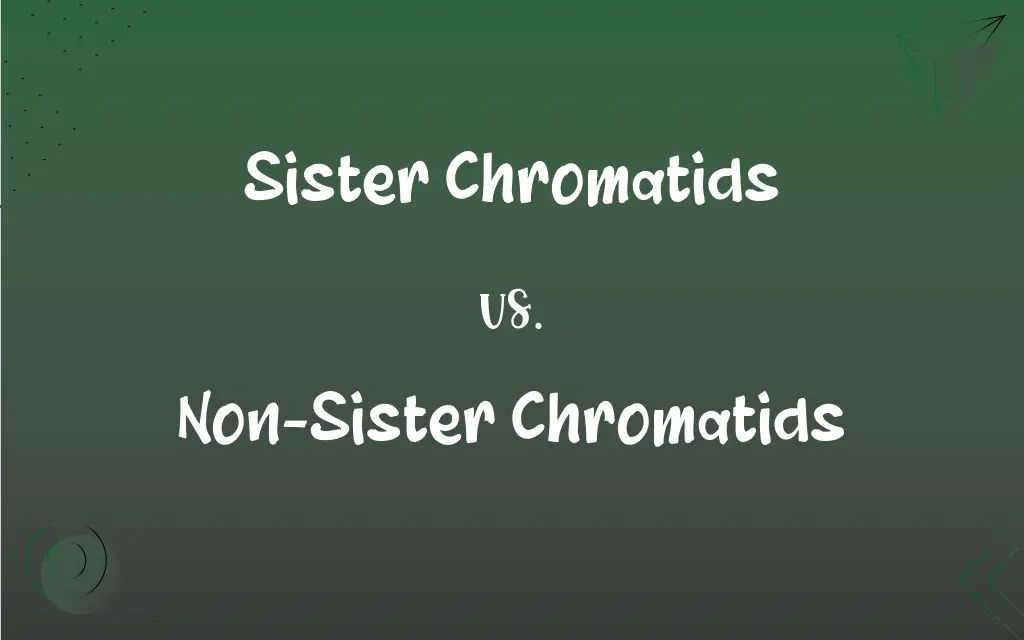Sister Chromatids vs. Non-Sister Chromatids: What's the Difference?
Edited by Aimie Carlson || By Harlon Moss || Updated on October 30, 2023
Sister chromatids are identical copies of a single chromosome held together at the centromere. Non-sister chromatids belong to different homologous chromosomes and aren't identical.

Key Differences
Sister chromatids refer to two identical copies of the same chromosome formed as a result of DNA replication. They are conjoined at a region known as the centromere and are vital during cell division. On the other hand, non-sister chromatids pertain to the chromatids from two different members of a pair of homologous chromosomes. They are not identical and come into close contact during meiosis, a process crucial for genetic variation.
Sister chromatids become particularly important during mitosis, the process of cell division in somatic cells. When the cell divides, these chromatids are separated to ensure that each daughter cell gets an identical set of chromosomes. Non-sister chromatids, contrastingly, do not separate in a similar fashion. Instead, they undergo genetic recombination during meiosis, which results in the exchange of genetic material.
Every chromosome, post-DNA replication, consists of two sister chromatids. They are essentially duplicates of each other, containing the same genetic information. Non-sister chromatids, however, come from two distinct but homologous chromosomes. While they carry genes for the same traits, the specific versions or alleles of those genes might differ.
In the context of genetic diversity, sister chromatids don't play a direct role since they are identical. Non-sister chromatids, in contrast, are central to the process of creating diversity in offspring. The crossing-over between non-sister chromatids during meiosis is what gives rise to genetic variation within species.
Comparison Chart
Definition
Identical copies of a single chromosome.
Chromatids from different homologous chromosomes.
ADVERTISEMENT
Origin
Result from DNA replication.
Come from separate chromosomes of a homologous pair.
Role in Genetic Diversity
Do not contribute directly.
Responsible through crossing-over in meiosis.
Genetic Content
Identical.
Different, but related.
Separation during Cell Division
Separate during mitosis.
Do not separate similarly; undergo recombination in meiosis.
Sister Chromatids and Non-Sister Chromatids Definitions
Sister Chromatids
Sister chromatids contain identical genetic information.
Any mutation in a gene will be reflected in both sister chromatids.
ADVERTISEMENT
Non-Sister Chromatids
Non-sister chromatids belong to different homologous chromosomes.
During meiosis, non-sister chromatids from homologous chromosomes can exchange genetic material.
Sister Chromatids
Sister chromatids are products of DNA replication.
Before a cell divides, its DNA replicates, forming sister chromatids for each chromosome.
Non-Sister Chromatids
Non-sister chromatids can undergo crossing-over during meiosis.
Genetic variation in offspring can be attributed to exchanges between non-sister chromatids.
Sister Chromatids
Sister chromatids are conjoined at the centromere.
The centromere holds the sister chromatids together until cell division.
Non-Sister Chromatids
Non-sister chromatids represent genetic variants within homologous chromosomes.
A trait determined by genes on non-sister chromatids can manifest differently based on the specific allele present.
Sister Chromatids
Sister chromatids separate during mitosis.
During anaphase, sister chromatids are pulled apart to opposite poles of the cell.
Non-Sister Chromatids
Non-sister chromatids are not identical, though related.
Non-sister chromatids may have different alleles for the same gene.
Sister Chromatids
Sister chromatids are duplicated copies of a chromosome.
After DNA replication, a chromosome consists of two sister chromatids.
Non-Sister Chromatids
Non-sister chromatids play a role in genetic recombination.
Crossing-over between non-sister chromatids introduces genetic diversity.
FAQs
Why are non-sister chromatids important for genetic diversity?
Non-sister chromatids undergo genetic recombination during meiosis, leading to genetic variation.
When do sister chromatids separate?
Sister chromatids separate during mitosis, ensuring each daughter cell gets an identical set of chromosomes.
Can non-sister chromatids exchange genetic material?
Yes, non-sister chromatids can exchange genetic material through a process called crossing-over during meiosis.
Do non-sister chromatids play a role in mitosis?
No, non-sister chromatids' main role is in meiosis, especially during genetic recombination.
When do non-sister chromatids come into close contact?
Non-sister chromatids come into close contact during the prophase I of meiosis.
Are the genes on sister chromatids always the same?
Yes, the genes on sister chromatids are always identical.
Are sister chromatids present in non-dividing cells?
Sister chromatids are formed following DNA replication and before cell division, so they're not present in non-dividing cells.
How do non-sister chromatids differ from sister chromatids?
Non-sister chromatids belong to different homologous chromosomes and aren't identical, unlike sister chromatids.
Are sister chromatids identical in their genetic information?
Yes, sister chromatids have identical genetic information.
Do sister chromatids contribute to genetic diversity?
Directly, no. Sister chromatids are identical and don't introduce genetic variation.
How do non-sister chromatids affect inheritance patterns?
Through crossing-over, non-sister chromatids can introduce new genetic combinations that affect inheritance patterns.
What are sister chromatids?
Sister chromatids are identical copies of a single chromosome, conjoined at the centromere.
Do non-sister chromatids always have different alleles?
Not always, but non-sister chromatids can carry different alleles for the same gene.
Where are sister chromatids held together?
Sister chromatids are held together at the centromere.
Can non-sister chromatids be from the same chromosome?
No, non-sister chromatids come from different members of a pair of homologous chromosomes.
How are sister chromatids formed?
Sister chromatids are formed as a result of DNA replication.
In which phase of cell division are sister chromatids separated?
Sister chromatids are separated during the anaphase of mitosis.
How do non-sister chromatids contribute to genetic diversity in offspring?
Non-sister chromatids undergo recombination during meiosis, resulting in offspring with varied genetic combinations.
Do sister chromatids play a role in meiosis?
Yes, sister chromatids play a role, especially when they separate during meiosis II.
How do non-sister chromatids differ in terms of genetic content?
Non-sister chromatids carry genes for the same traits, but specific alleles might differ.
About Author
Written by
Harlon MossHarlon is a seasoned quality moderator and accomplished content writer for Difference Wiki. An alumnus of the prestigious University of California, he earned his degree in Computer Science. Leveraging his academic background, Harlon brings a meticulous and informed perspective to his work, ensuring content accuracy and excellence.
Edited by
Aimie CarlsonAimie Carlson, holding a master's degree in English literature, is a fervent English language enthusiast. She lends her writing talents to Difference Wiki, a prominent website that specializes in comparisons, offering readers insightful analyses that both captivate and inform.































































